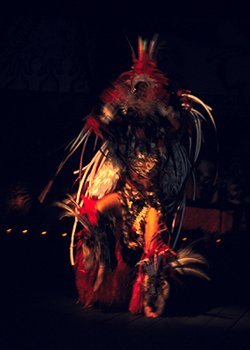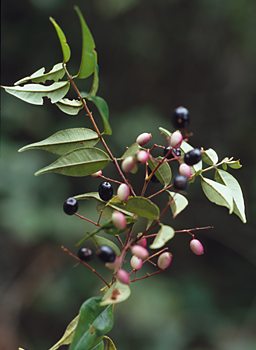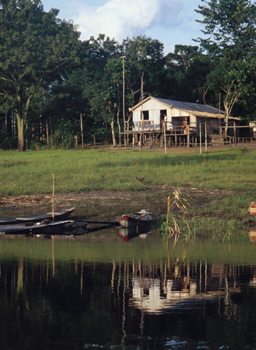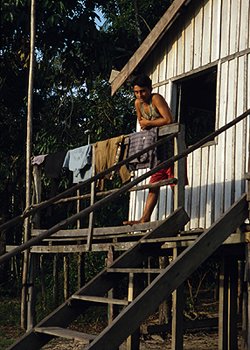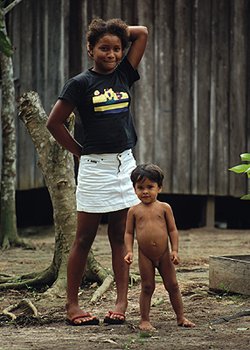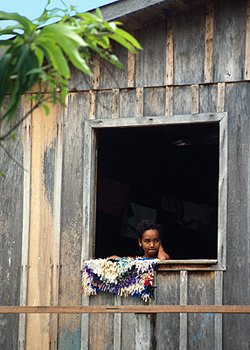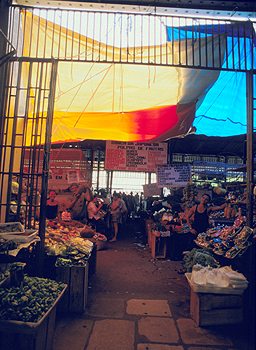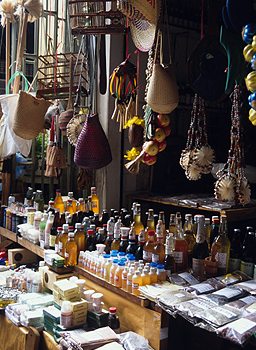
by Bonnie Pelnar, Under Watercolours
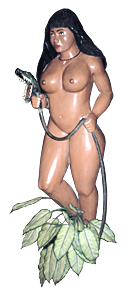
I had the opportunity to take a trip to a jungle lodge in the Amazon in Brazil. For anyone planning to travel there, you might find this trip report and photo collection useful. This was my first trip to the area and I was pleasantly surprised with the experience. The trip was in the month of January.
Other than a lot of mosquitoes in the jungle, there were not many insects around the hotel or even in the villages or on the beaches we visited. A heavy-duty mosquito repellent containing DEET is still recommended, because you will not want to miss any of the jungle treks. The weather was hot and humid when the sun came out, but got cooler and quite comfortable at night. We would also enjoy an occasional torrential downpour that would last for 15-30 minutes, then clear up for several more hours of sun.
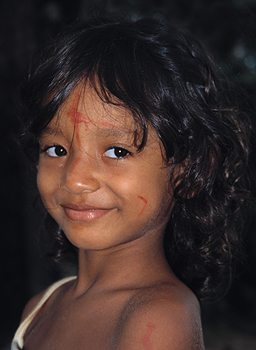 Preparation for a trip to the Amazon involves not only the hotel and air reservations but also requires a visa and possibly some recommended vaccinations. The process of getting the visa was much more painful than the Yellow Fever shot or the side affects of Larium, an anti-malarial. The Brazilian Consulate in Los Angeles is difficult to reach by phone, does not have a web site, and is terribly ill equipped to help anyone who is not familiar with the process of obtaining a visa. The LA office refuses to allow any application by mail or Fed Ex and are rude and not at all helpful when you do go there. It is possible to work with a visa service and after having done it myself, I would recommend paying someone else to do it for you… at any cost. The process of obtaining a visa takes at least five working days during the busy season. After two miserable trips to Brazilian Consulate in the most traffic-congested area of West Los Angeles, I had everything in hand to make the trip.
Preparation for a trip to the Amazon involves not only the hotel and air reservations but also requires a visa and possibly some recommended vaccinations. The process of getting the visa was much more painful than the Yellow Fever shot or the side affects of Larium, an anti-malarial. The Brazilian Consulate in Los Angeles is difficult to reach by phone, does not have a web site, and is terribly ill equipped to help anyone who is not familiar with the process of obtaining a visa. The LA office refuses to allow any application by mail or Fed Ex and are rude and not at all helpful when you do go there. It is possible to work with a visa service and after having done it myself, I would recommend paying someone else to do it for you… at any cost. The process of obtaining a visa takes at least five working days during the busy season. After two miserable trips to Brazilian Consulate in the most traffic-congested area of West Los Angeles, I had everything in hand to make the trip.
The 9:30 p.m. TAM Airlines departure from Miami brought us into Manaus, Brazil at 3:30 a.m. It took forever to get through the customs and immigration line there. Nobody was in a hurry to help anything make things move faster in spite of arriving passengers who were likely to miss their connections. The hotel had an air conditioned bus waiting to pick up the arriving passengers. Here we met Michael, our tour guide for the next four days. We stopped off at the Monaco Hotel (owned by the same guy as Ariaù Amazon Towers) to have breakfast and watch the sunrise over Manaus. Next we were taken to the Tropical Hotel, the only five-star in Manaus, where we caught our ferry boat to the Ariaù Amazon Towers.
The water in the river is deep red-orange from the tannic acid produced from the decomposition of leaves and trees in the river. Michael pointed out that the river can rise as high as 20 meters during the rainy season and in the past has flooded many parts of Manaus. Most buildings near the river are floating structures to accommodate this change. This water of the Rio Negro would join the Solimões River just downstream from Manaus to form the Amazon River.
We boarded the double-decked river boat for a two and a half hour trip to the hotel. Having had little sleep in the last 16 hours, I slept most of the way, as did many of the others.
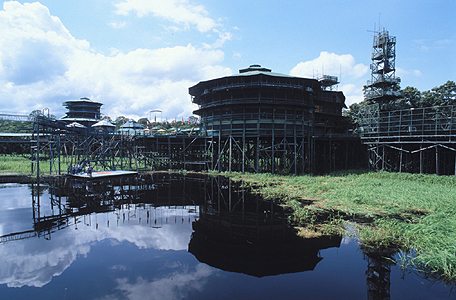 Once we arrived at the hotel we had very little time for rest. Michael wanted to show us everything and take us everywhere. He is one of the best guides I have seen in any part of the world, but we did tease him about the intense schedule. He is well educated and knowledgeable about the area and is enthusiastic about sharing his knowledge with guests. He had many interesting stories and facts that came with each adventure and the trip would not have been nearly as interesting without his assistance. At the time we were there, he was working as a freelance guide for Ariaù Amazon Towers. He also guides trips to other parts of the Amazon. We would highly recommend his services in the event any reader is thinking about planning a trip to the Amazon.
Once we arrived at the hotel we had very little time for rest. Michael wanted to show us everything and take us everywhere. He is one of the best guides I have seen in any part of the world, but we did tease him about the intense schedule. He is well educated and knowledgeable about the area and is enthusiastic about sharing his knowledge with guests. He had many interesting stories and facts that came with each adventure and the trip would not have been nearly as interesting without his assistance. At the time we were there, he was working as a freelance guide for Ariaù Amazon Towers. He also guides trips to other parts of the Amazon. We would highly recommend his services in the event any reader is thinking about planning a trip to the Amazon.
The hotel was a spectacular sight as we pulled off into the Ariaù Passage to get to the main dock. There was no dry land in sight. Only swamp, rainforest and this huge wooden tower structures built on stilts. The round green buildings looked like some kind of primitive warehouse built on top of a wooden roller coaster. The long raised walkways connected the many buildings that were spread out across several acres. We were greeted by rambunctious monkeys and near naked women with tropical drinks.
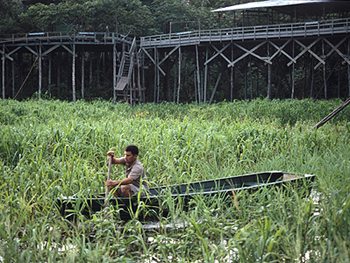
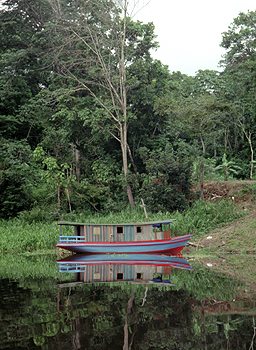
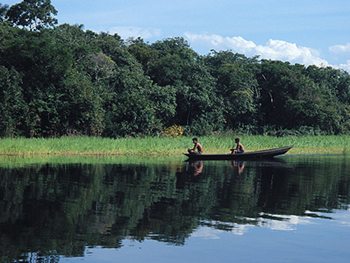
Reconnaissance Tour of Ubim's Passage & Lake
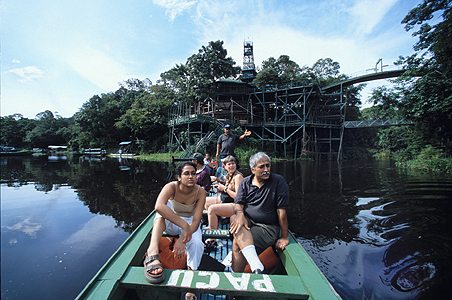
After check in and a shower, we regrouped for our first excursion, a reconnaissance tour of Ubim's passage and Ubim's Lake from the local long canoes used by everyone there. Michael pointed out many of the unique birds and trees along the way. We stopped off at the Greenland lodge, another small Amazon jungle lodge to sample Brazil nuts and cashew fruit right off the tree. We had very calm waters and lots of sun and returned back to the hotel around sunset.
All meals were served in the large tower, which looked like a big green four-layer cake. Reception was on the ground level and several restaurant areas were above that. All the meals were buffet style. The food was pretty good, always serving several varieties of fish, and beef, chicken, or duck. There was plenty of variety but it got a bit repetitious by the fourth day. They also serve soft drinks, beer, wine and mixed drinks for an extra charge.
After dinner we had scheduled another canoe trip to look for caiman (one of four alligator species in the area) but the weather started to kick up and Michael decided to postpone the trip until the next night.
During the few and far-between moments of free time we did have, I spent either taking pictures of the monkeys and the macaw parrots or browsing through the gift and medicine shops at the hotel. By the end of the first day we all felt like we had been there for much longer than only one day.
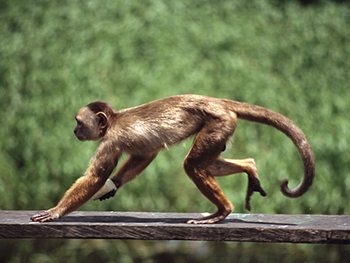
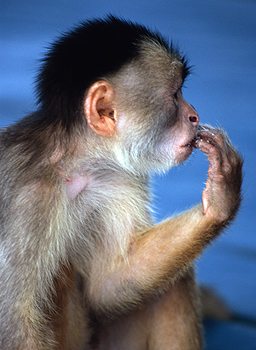
At 5:00 a.m. the next morning we got up for breakfast and a canoe trip to the Rio Negro to watch the sunrise. The waters were again very calm and we enjoyed what nature morning shared with us and listened to Michael's stories of the Amazon. Then back to the hotel for breakfast.
Jungle Trekking
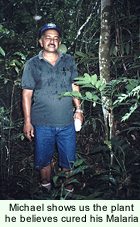 Our next adventure was a trek through the jungle and a visit to a local man's home. This area was a bit further up Ubim's passage, but the water was very calm and we saw many of the pink dolphins (Boto vermelho) often seen in that area.
Our next adventure was a trek through the jungle and a visit to a local man's home. This area was a bit further up Ubim's passage, but the water was very calm and we saw many of the pink dolphins (Boto vermelho) often seen in that area.
The jungle trek was easy walking, but there were a lot of mosquitoes, all of them feasting on me, even through a layer of DEET. Michael pointed out many of the plants and trees used for various medicinal purposes. There have been entire books written on the medicines that come from the Amazon. Many of these medicines could be purchased at a small shop located at the hotel.
The local man and his family had a small handicraft shop set up from which we could buy items made by the local artisans. In the small shack behind the shop the women cooked us fresh caiman and fish as here curious children overlooked.
Ariau Amazon Towers
After another lunch at the hotel, we did a hotel tour. Michael took us to see the Tarzan tree-house accommodations that were located in a secluded part of the hotel. The hotel owner was building more of them around the area and we enjoyed watching the local construction workers lift a huge fiberglass swimming pool three stories into the trees.
The standard rooms at this hotel are exactly that. Tower 6, where we stayed has three layers of standard rooms that are built in a circle around a central core hallway. Above these rooms are several more layers of higher level accommodations, with the Cosmic Suite located at the top. Everything here is built from local timber and is decorated with wood carvings and paintings. The rooms are comfortable with central air conditioning (which I found to be too cold) and have a small fenced in balcony that overlooks the entire complex. The bathrooms have a standard toilet, sink and shower, but no hot water. There is also a small refrigerator in each room and a bowl of local fruit. When I go back, I'll try to reserve one of the tree-house rooms, but would still enjoy the stay if that were not possible.
Certain aspects of the accommodation were entertaining in themselves. For some reason, the floors were all slanted from the inside down. You could roll a piece of fruit across the room just by setting it down at the entrance. I never quite figured out the purpose of this. In the mornings I was often entertained by monkeys who would hang outside the screens to watch me brush my teeth, then they would pee on my balcony.
Teriano Indian Ritual
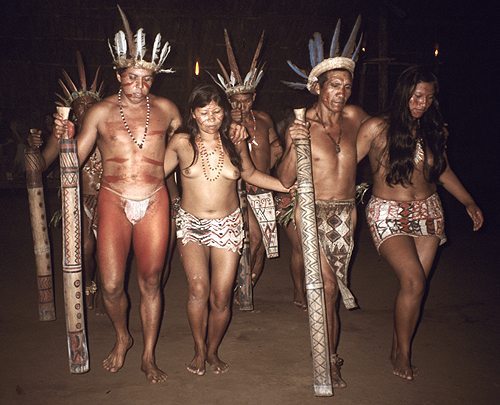 After dinner we got back into the canoes to head upstream for a traditional Indian ritual dance. These Indians were the Teriano tribe from the upper Rio Negro Tucano nation, but had moved to Manaus, only to find themselves living in poverty. To reestablish their roots in the jungle they made a deal with the hotel owner for some land in exchange for performing for the hotel guests. Normally this would sound a bit "touristy" but it wasn't anything like that. They perform this ritual dance every night to thank their gods, whether guests are present or not. The dancers wore leaves and feathers and the small instruments they played were made from hollow bamboo sticks. The room was very dark, only lit by several torches, but they did encourage photos and video. They then thanked us for joining them by inviting us to join them in eating caiman and drinking their local drink. Because things didn't look sanitary, we choose to pass on the food and drink.
After dinner we got back into the canoes to head upstream for a traditional Indian ritual dance. These Indians were the Teriano tribe from the upper Rio Negro Tucano nation, but had moved to Manaus, only to find themselves living in poverty. To reestablish their roots in the jungle they made a deal with the hotel owner for some land in exchange for performing for the hotel guests. Normally this would sound a bit "touristy" but it wasn't anything like that. They perform this ritual dance every night to thank their gods, whether guests are present or not. The dancers wore leaves and feathers and the small instruments they played were made from hollow bamboo sticks. The room was very dark, only lit by several torches, but they did encourage photos and video. They then thanked us for joining them by inviting us to join them in eating caiman and drinking their local drink. Because things didn't look sanitary, we choose to pass on the food and drink.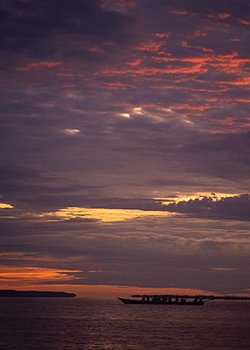 On the way back to the hotel, we began our search for the elusive caiman. The guides had bright car-battery powered lights that they used to spot the red glow of the caiman's eyes in the distant grass. They would maneuver the canoes through the floating grass until they got directly over the caiman, hidden under the water. The canoe driver would then jump off the front of the canoe onto the back of the caiman, hopefully to grab and hold the mouth closed before it had a chance to turn around and bite. The guides found many prospects, but either the caiman was too big to attempt, or he missed when he made the jump. Since it was getting late, we decided to try again the next night.
On the way back to the hotel, we began our search for the elusive caiman. The guides had bright car-battery powered lights that they used to spot the red glow of the caiman's eyes in the distant grass. They would maneuver the canoes through the floating grass until they got directly over the caiman, hidden under the water. The canoe driver would then jump off the front of the canoe onto the back of the caiman, hopefully to grab and hold the mouth closed before it had a chance to turn around and bite. The guides found many prospects, but either the caiman was too big to attempt, or he missed when he made the jump. Since it was getting late, we decided to try again the next night.
Totally exhausted, we all went to bed immediately when we got back to the hotel.
Acajatuba
The next morning we made a trip to a local village called Acajatuba on Lake Acajatuba. A young woman founded this village when she was 16 years old and she still lives there today, where she proudly greets tourists. The village is now home to about 35 families. It has three small churches, one of them being nothing more than a couple of covered benches. There is also a boat builder who lives in the village, so we got a tour of his "factory". The local handicraft store here had some of the best souvenirs we've seen so far. The local bar/restaurant had a huge anaconda skin that was proudly displayed on the wall over the bar. The owner was proud to show us his collection of anaconda ribs and teeth. The ride back was rough since the weather was a bit stormy and we all got pretty wet.
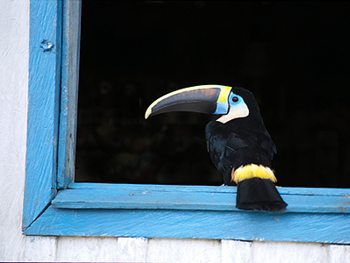
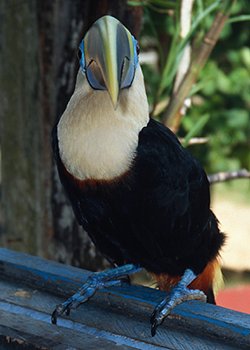
By the time we got back to the hotel and had lunch, the weather completely cleared up and we gathered for the afternoon trip to the archipelago in the Rio Negro across from the hotel. The boat was much bigger and was covered, a welcome change to the wooden canoes we all had sore butts from. One of the other guides told us fisherman's anaconda stories and details of how he trained to be a Green Beret for the Brazilian Army by spending six months surviving in the Amazon rain forest without any outside assistance.
We spent about an hour on the white sandy beach and went swimming in the black water of the Rio Negro.
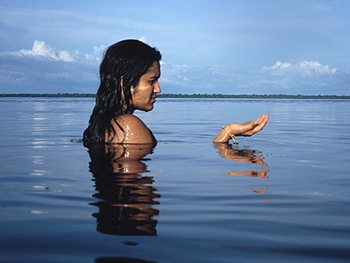
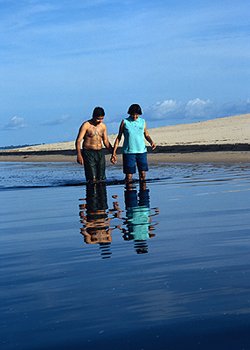
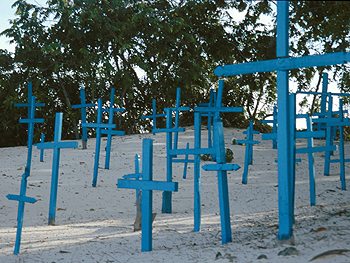
When we returned back to the hotel we headed right out on another canoe to go fishing for Piranhas. Several people in the group did catch a few small ones, and even a red-bellied Piranha, one of the most vicious, but I only caught a catfish that was about 4" long.
Caiman Hunting
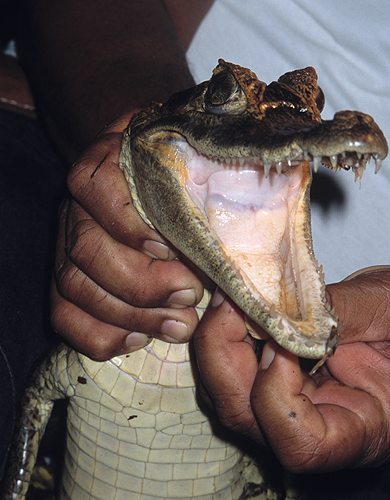
That night after dinner we headed back out to hunt the caiman who had been so elusive the night before. This time we did spot many. There were red glowing eyes everywhere and the feeling was quite eerie. Our boat driver jumped head into the dark black water and brought us a small female caiman. Michael gave use a whole lesson on the critter and after we all took photos, we released it back into the murky water.
Next we headed to a Cultural Show that was to take place in the auditorium. This was very "touristy", but was still colorful and entertaining.
Meeting of the Waters
The next morning we packed and headed out to catch our speedboat back to Manaus. Before the trip to the airport we took the boat down to where the Rio Negro and the Solimões Rivers merged to form the Amazon. Since the source and paths of both rivers are so dramatically different, so is the water. The Rio Negro is made of clear black water, which is warmer and moves slower than the Solimões, whose water is muddy brown, colder and rapid. When the two meet the waters do not mix but form a very visible line contrasting the differences between them. The waters travel 8 Km down the Amazon before they finally do mix.
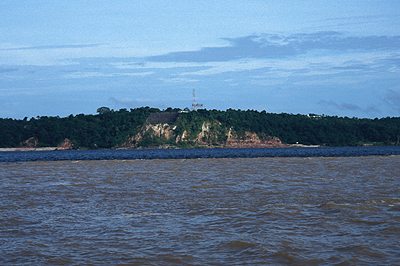
Our next stop was to the harbor to catch our bus to the market in Manaus where we could purchase handicrafts, spices, nuts and food products. The prices here were very reasonable. We made a quick stop at the Holiday Inn to look at some gemstones being sold there. Although they boasted prices that were 80% off of retail, the prices were actually about 500% more than what one could buy in the US from Swest or Rio Grand Jewelry suppliers. The prices were somewhat negotiable, but if once could get the sales person to come down even 50% you would still be paying two and a half times what you should be, and not worth taking the risk of questionable quality.

